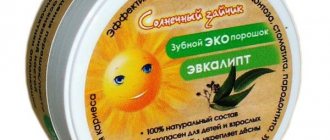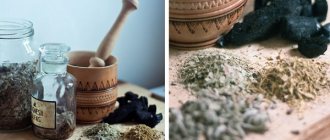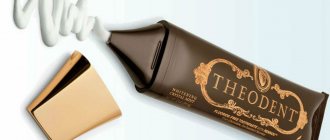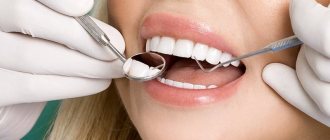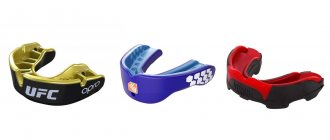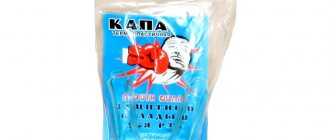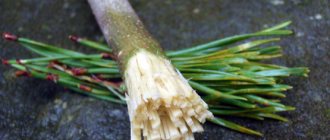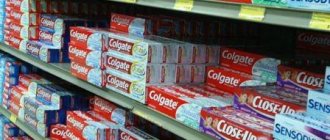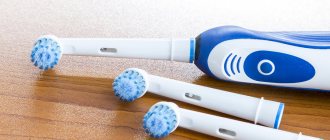How is tooth powder better than paste and what harm can it cause to teeth?
Before we had toothpaste at our disposal, a special powder was used to clean enamel from plaque. It gained popularity back in the 18th century because it did an excellent job with its immediate task, and also helped freshen breath and prevent many dental problems. Later, the paste forced the product out of the market, but today you can increasingly hear that the composition of tooth powder is much harmless, and maybe even more effective than modern oral care products. Is this really so - we will understand further in this article.
Compound
The main active ingredient of tooth powder is chalk ground in a special way. It acts as an abrasive ingredient, helping to remove plaque and whiten teeth from various food dyes. The mass fraction of chalk in the product reaches almost 98%.
In addition to the main active ingredient, the powder may include the following components:
- baking soda - has a bleaching property;
- white clay – helps reduce existing inflammation;
- sea salt – is an antiseptic and helps restore gums;
- crushed medicinal plants - accelerate tissue restoration and wound healing;
- essential oils – to reduce inflammation and create aroma.
The composition of tooth powders may vary depending on the functions it is intended to perform. So, the bleaching agent must include soda and white clay. The drug to relieve bad breath will contain essential oils of mint or menthol.
What we are dealing with: what is in the product
To find out what benefits and harm powder can bring to teeth, you first need to understand what it is, what it consists of, and why this method of cleansing enamel is good and useful. Essentially, this is the same paste, only in dry form and without the addition of artificial components that enhance effectiveness. Due to the fact that the powder consists of a huge number of tiny abrasive particles, it provides high-quality cleaning from plaque. The effect becomes noticeable after 2-3 applications. Today in the assortment you can find different types of dry cleaning compositions, and all of them can differ in the following parameters:
- aromatic and flavoring additives,
- additional natural ingredients,
- the purpose of the effect is to whiten teeth, heal and strengthen hard tissues, remove yellow plaque, which is especially important for a smoker.
Tooth powder is the same paste, only in dry form and without the addition of artificial components.
The product is sold in compact round boxes with a tight-fitting lid. It should be stored in a dry place protected from moisture.
Features of the composition - how the product “works”
If at the beginning of its appearance the powder was prepared on the basis of ordinary chalk, today its composition has changed significantly and has been enriched with components that are useful and safe for enamel. Chalk remained the base, but now the powder is made using not just crushed, but chemically precipitated substance. The abrasive particles are smaller and less damaging to the enamel.
Thus, the presence of sea salt in the composition ensures remineralization of hard tissues and stimulates metabolic processes in the gums, baking soda allows you to lighten teeth and restore their natural whiteness, and extracts of medicinal herbs have a beneficial effect on oral health in general. Some manufacturers offer products based on white clay. It is believed to provide a more gentle cleansing without sacrificing effectiveness.
The presence of sea salt in the composition ensures remineralization of enamel
Homemade recipes
Recently, the number of those who care about their health and use only natural, environmentally friendly products has increased. But manufacturers are not always conscientious about the composition of their products, so if you want to be sure that the cleaning product is 100% safe, you can prepare it yourself.
Natural tooth powder recipes:
- Basic . You will need white clay (1 part), coarse salt, maybe pink (1/5 part), soda (1 part). All components need to be ground in a coffee grinder to a powder state and mixed. The finished product is stored in an airtight jar.
- Herbal. Take sage and mint (dried herbs) ½ part each, chop, sift through a fine sieve and add to the base base. Also add 5-8 drops of mint or any citrus essential oil to the composition and mix everything thoroughly.
- To brighten enamel. To make your own whitening tooth powder, add crushed activated carbon (1/2 part) and tea tree oil (7 drops) to the base. All that remains is to mix all the ingredients using a coffee grinder.
- Antibacterial. Take 5 tbsp. l. white clay, 0.5 tbsp. l. sea salt (crushed), 1 tbsp. l. soda, 0.5 tsp. clove powder, 0.5 tsp. cinnamon and 10 drops of tea tree oil. Mix all of the above until a homogeneous mass is obtained.
- For toothache. Prepare 200 g of purified crushed chalk, soda (70 g), finely ground salt (5 g), cinnamon and mint essential oils (12 and 25 drops each, respectively). Mix everything in a coffee grinder for a minute and the powder is ready.
What types of dental powders are there - popular manufacturers
Before moving on to the question of how to use the product correctly, you need to familiarize yourself with the assortment presented today. Below are some really good proven products from top brands:
- Gum Gold: has an additional anti-inflammatory effect on the mucous membrane, and it contains extracts from more than a dozen different medicinal plants that prevent further growth of bacteria and help restore the natural microflora of the oral cavity. The cost of one package is about 300 rubles,
- “Mint” from “Avant”: additional components help relieve mild inflammation, carry out antibacterial treatment of surfaces, strengthen teeth, but overall the composition is standard. The cost is 50 rubles,
- “Whitening” from “Phytokosmetik”: the product does not contain dyes or flavors, is suitable for those prone to allergies, and has a pronounced whitening effect. The product costs about 70 rubles.
Recently, Japanese tooth powder for smokers from the Lion company has become very popular. The manufacturer promotes its product as a solution to the problem of nicotine plaque, but all such products have approximately the same composition with only minor differences in additional components. The conclusion suggests itself that this is just a cunning marketing ploy, and simple, and therefore cheaper, analogues will cope with the task no worse.
Using tooth powder at home
Tooth powder can be used far beyond its main purpose - thanks to the calcium carbonate and soda it contains, it has found application in households and even in cosmetology. Tooth powder is valued primarily as a soft abrasive that can be used to gently and at the same time effectively clean any surface.
Here are some tips for non-standard use of this product in everyday life:
- a mixture of tooth powder and hydrogen peroxide helps to quickly and effectively eliminate blackheads on the skin. A mixture of powder and peroxide should be applied to the problem area of the face and massaged for a while. The combination of the mild abrasive properties of calcium carbonate and the antiseptic effect of essential oils gives excellent results;
- tooth powder perfectly helps in cleaning items made of silver and cupronickel, eliminating darkening and giving the items shine. The powder must be diluted in a small amount of water to form a thick paste, then apply this paste to the surface of the product and leave for a while, then rinse with running water;
- You can also clean porcelain and earthenware products with this product - calcium carbonate and soda gently remove dirt without scratching the products themselves;
- tooth powder can also be used to remove small rust stains;
- it can also be used for cleaning acrylic surfaces that are very sensitive to abrasive effects;
- this product is used to clean white fabric products (most often sports shoes are cleaned this way) - apply a little thick paste of powder and water to the stain, wait until it dries and remove the remaining paste with a dry cloth;
- You can also clean white leather products (shoes, bags, etc.) in a similar way - to do this, mix tooth powder with a small amount of lemon juice and apply this mixture to the contaminated area and leave for a few minutes, then wipe with a damp cloth.
The low cost of tooth powder makes it possible to buy it for purely household purposes - this is much more profitable than purchasing special cleaning products. This is exactly what many housewives do.
Many people perceive tooth powder as a relic of the past. However, in reality, this tool can find its application today. Tooth powder has many properties that customers appreciate - naturalness, affordability, and a relatively mild abrasive effect. This product can be useful not only for cleaning teeth - the same properties allow it to be successfully used for household purposes.
Powder or paste - pros and cons
Opinions on this matter are divided, so it is difficult to give a definite answer to the question of which is better. Some experts are confident that tooth powder is safer and more effective, while others insist that it is completely unsuitable for daily cleaning and cannot be considered a full-fledged analogue of toothpaste. So that you can draw your own conclusion, here are some comparisons between these two products:
- dry composition is a huge amount of tiny particles that contribute to better removal of plaque. Its systematic use helps maintain the natural whiteness of your smile,
- the product in the form of a dry substance does not contain artificial components and restores the normal balance in the oral cavity, prevents the destruction of hard tissues and the development of inflammatory processes due to the active activity of bacteria,
- modern paste-like products contain additional medicinal components, the action of which is aimed at eliminating and preventing a wide variety of dental problems,
- the paste is produced in a sealed convenient tube, while bacteria can settle on the powder, and it quickly becomes unusable,
- the dry product does not provide proper antimicrobial treatment, which cannot be said about the paste,
- Cleaning powder is contraindicated for use by people with sensitive enamel. Also, it should not be used every day, since in this case the abrasive particles can injure and weaken the protective layer of the teeth,
- Sometimes pastes contain sodium lauryl sulfate or triclosan1, which are very harmful. Powders contain only natural ingredients.
Pastes are intended for daily use, and powder once every 3 days
“And I’ve been adding powder to the paste for six months now. I don’t know what kind of chemical reaction is happening there, but my teeth have clearly become several shades lighter. There is no hypersensitivity, everything is as usual. Another point: I smoke and drink coffee in the morning. So in my case, the old proven remedy really saves me. An ordinary toothpaste, and even a whitening toothpaste, did not give such an effect.”
Anatoly K., Moscow, from correspondence on the forum www.32top.ru
The key difference is that toothpastes are intended for daily use. It is better to use the dry product in courses for targeted cleansing of plaque and deposits to restore the natural whiteness of the smile. It is allowed to use tooth powder once every 3 days - this frequency is optimal for maintaining the required level of hygiene. At the same time, you need to brush your teeth with regular toothpaste as usual - twice a day.
How to use tooth powder correctly?
In order not to harm your own teeth, you should follow certain recommendations when using tooth powder:
- do not use it too often - dentists recommend brushing your teeth with powder no more than twice a week, and the rest of the time using a paste;
- During the procedure, use a toothbrush with soft bristles to reduce the abrasive effect on the enamel;
- do not brush your teeth for too long - five minutes will be more than enough;
- Do not dip a wet brush into the powder. This is a simple and convenient, but absolutely unhygienic way of applying the product. Prolonged exposure to moisture on the powder not only changes its properties, but also promotes the proliferation of pathogenic bacteria. It is best to dilute the powder in a small amount of water before use until it becomes a thick paste and then apply it to the brush.
It is worth paying attention to the fact that the powder does not foam when brushing your teeth. This is completely normal and is not a sign of low quality product.
Rules of application
To get results without causing damage to your dental health, you must strictly follow the instructions for use. Before you start using the product, carefully read the following recommendations:
- you should not put wet bristles into a dry composition - it is better to pour the product into a different container each time and dilute the product in it,
- you need to add a little water to the composition or mix it with a paste,
- You should use a soft brush so as not to further injure the protective layer of your teeth,
- Duration of the procedure – 3-5 minutes,
- dry product should be used no more than once every 3 days,
- At the end of the procedure, you should rinse your mouth thoroughly with water.
First, it is recommended to consult with your dentist and find out the current condition of the enamel. The doctor will tell you which remedy is best to choose in your case.
What damage can frequent use cause?
If the product is used incorrectly, it may cause some damage to your teeth. Of the possible negative consequences, dental experts identify the following problems:
- thinning of the enamel due to frequent use of the product or due to too intensive cleaning,
- injury to open wounds on the mucous membrane, which leads to their enlargement and exacerbation of painful sensations, increasing the risk of infection,
- the likelihood of bacteria penetrating into tissues and developing various dental ailments, which is largely due to non-compliance with storage recommendations.
With frequent use of the powder, the enamel can become thinner and become sensitive.
To avoid undesirable consequences, you need to observe moderation in everything, do not use the powder too often and follow the instructions. It is also important to follow storage rules.
Consumer Reviews
This product is in little demand among consumers due to their low awareness of the benefits of the compounds. People who used the product in question to clean their teeth noted its high effectiveness against soft deposits. After just one application, the enamel became lighter and smoother. Consumers also note the versatility of the powder. They use it to clean silver items or light leather shoes.
Among the disadvantages of the drug, buyers note a short-lived feeling of freshness in the mouth, the same applies to the cleansing effect. After using the powder, many users noticed an increase in tooth sensitivity to temperature stimuli.
The powder cannot be used instead of paste for high-quality oral hygiene. The fact is that the product is considered outdated and is not suitable for comprehensive dental care. However, in combination with traditional toothpaste, it can be effectively used to whiten teeth or remove soft plaque. The basic rule when using the drug is not to press hard on the brush and to comply with existing dental contraindications.
How to store dry composition
Dental experts recommend storing the powder in a dry place, away from direct heat, humidity and temperature changes. The composition is sold in special plastic packaging with a sealed lid - this is the best container, but you need to make sure that moisture and dust do not get inside.
The composition should be stored in airtight packaging
How much does the product cost?
It is difficult to give a definite answer regarding how much tooth powder costs. Products with a simple composition and without additional additives will cost around 40-50 rubles per package. However, the assortment also includes more expensive products with additional strengthening, soothing or whitening effects - their price can vary between 200-300 rubles. The most expensive are foreign-made compounds, which are positioned to combat plaque in smokers. They can cost 500-600 rubles per package.
Price and where to buy
Standard varieties of tooth powder - “Special”, “Mint”, “Whitening” - are sold in any household chemicals store, and can also be found in pharmacies.
Of all the oral hygiene products, they are the most budget-friendly - the cost of one box of any of the listed types does not exceed 25 rubles.
A special “Biobeauty” product for active remineralization of thinned enamel with a high content of various minerals will cost about 450 rubles per package.
DentaEM powder, which combines anti-inflammatory and whitening agents, will cost 250 rubles per package.
Children's tooth powder “Sunny Bunny” with extracts of various medicinal plants, including string and oak bark, and also has a pleasant taste and aroma and will cost around 250 rubles.
You can purchase all these products at almost any pharmacy.
We prepare the product ourselves
The principle of preparation is quite simple, and if desired, a similar product can be made at home. In this regard, a lot of questions arise regarding how to make the product, how to dilute the components and what to add to the composition. Below is a simple and quick recipe:
- You can take medicinal clay as a basis, and other components can be essential oils, soda, sea salt,
- after this you need to mix all the dry ingredients and try to grind them thoroughly. You can use a blender or coffee grinder,
- liquid oils should be added at the end.
Tooth powder can be made at home.
The finished composition should be stored in a dry and clean container. Make sure that no dirt or moisture gets in there. Otherwise, the product will very quickly become unusable.
Types and composition of tooth powders
The main component of most tooth powders is calcium carbonate, obtained from chemically precipitated chalk.
It has a pronounced abrasive effect and is capable of not only removing soft plaque from teeth, but also softening hard plaque.
Also, sodium bicarbonate, a substance better known as baking soda, is often added to tooth powders - it enhances the abrasive properties and also helps regulate the acid-base balance of the oral cavity (with each meal, the acidity in the mouth increases, and tooth enamel is very sensitive to acids ; sodium bicarbonate, due to its alkaline properties, helps reduce acidity to a safe level).
Since both of these substances themselves are not very pleasant to the taste, various essential oils are added to the powders - they not only improve the taste and smell, but also have antiseptic and anti-inflammatory effects. Thus, the “Special” tooth powder, the most famous and popular, contains peppermint, anise and coriander oils, the “Family” toothpowder contains sage oil, the “Whitening” toothpowder contains lemon oil, and the “Mint” toothpowder, in addition to peppermint oil, also menthol is added.
There is an option for those who do not like the minty smell and taste of most powders - “Special” powder with orange essential oil. In addition to the oil, which gives a pleasant citrus aroma, saccharin is added to this product, a safe chemical sweetener that improves the taste of the powder.
Benefits and potential harm
So, we are convinced that it is too early to retire tooth powder, and it can be an indispensable assistant in dental care. Here are the key advantages of using an old proven product:
- absence of artificial and toxic components,
- thorough cleaning of the enamel due to the abrasiveness of the composition,
- the ability to remove plaque and even hardened dental plaque - bulky stone will have to be removed with ultrasound,
- the property of whitening teeth, returning them to their natural shade,
- additional polishing of the enamel to give a natural shine,
- calming effect, antimicrobial treatment of mucous membranes,
- additional saturation with fluorine if present in the composition,
- normalization of the natural balance of microflora,
- prevention of caries and other pathological processes in the oral cavity,
- affordable price.
Today, powder products that are used to clean teeth have very few negative characteristics. Due to the high degree of abrasiveness, there is some danger of injuring the enamel, which can lead to its thinning and the development of hyperesthesia - hypersensitivity. In addition, the standard packaging lacks airtightness and a dispenser, which makes using the product a little more difficult. For the same reason, the powder can quickly deteriorate, especially if it is stored in inappropriate conditions. Overall, this is an effective additional measure that will improve oral hygiene and prevent many dental problems.
- Vasilyeva, L.A. Prevention and oral hygiene, 2008.
Dentist reviews
Dentists believe that the old tooth powder (produced under the Family brand) should not be written off due to the inconvenience of use. However, doctors do not advise some people to use dry toothpaste to care for their teeth in order to avoid unpleasant consequences.
Dentists believe that the statement that the powder removes tartar from the enamel is incorrect. Solid deposits can only be removed with the help of strong acids or special equipment located in the clinic
To whiten teeth, it is recommended to combine traditional toothpaste with dry toothpaste. Standard teeth brushing is carried out twice a day and in addition to this, powder is used 2-3 times. In the latter case, avoid applying strong pressure to the brush. It is impossible to completely replace the gel-like paste with dry paste, as this has a bad effect on the condition of the enamel. In addition, it is impossible to achieve comprehensive oral care with just one powder.
Doctors note the following contraindications to the use of dry paste:
- Enamel sensitivity;
- Predisposition of teeth to caries and destruction;
- Non-infectious diseases of the oral cavity: fluorosis, wedge-shaped defect, etc.;
- Individual intolerance to the components of the product.
